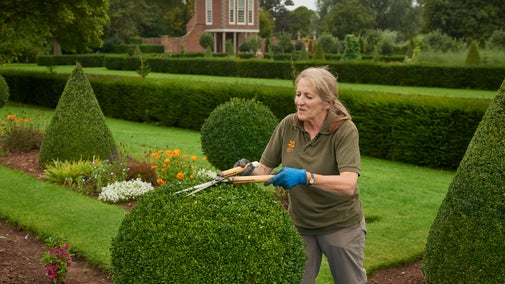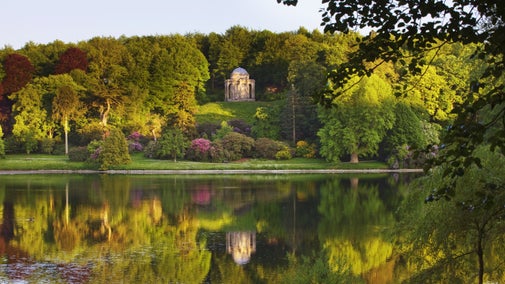
Discover more at Westbury Court Garden
Find out when Westbury Court Garden is open, how to get here, the things to see and do and more.

Westbury Court Garden is one of a few surviving 17th-century Dutch water gardens in the UK. Discover how it came to be created in Gloucestershire, its initial decline and how it was brought back to life with the help of archival research and artwork.
The garden was originally laid out between 1696 and 1705. It's heavily influenced by the fashions of late 17th and early 18th century European design, especially for this unusual type of water garden. The main features include canals, circular pool, topiary and vegetable gardens.
The main design was created by Maynard Colchester, who included in his plans the Long Canal, Tall Pavilion, the circular pool and the framework of walls.

Thousands of yew trees and holly bushes were planted to create a geometric pattern of hedges along with neatly shaped topiary.
The original garden was captured in an engraving by Dutch artist Johannes Kip in 1707 which shows the garden in a birds eye view.
The garden was designed to be productive as well as pleasant. Cardoons, artichokes and asparagus were grown as part of the seasonal planting, while tulips, irises, crocuses and hyacinths were planted alongside vegetables and fruit trees.
These foods became known as the 'rich man’s food' as it appeared on the tables of the wealthier families.
The canals were stocked with fish for the table and there was a rabbit warren to supply meat for the kitchen.
In the late 18th century formal gardens began to go out of fashion. Formal styles were gradually replaced with the more natural looking landscape gardens introduced by the popular gardener and landscape architect Capability Brown.
In 1805 the Colchester family demolished their house at Westbury and moved to another residence in the Forest of Dean. They kept the garden at Westbury but maintained it in a more low-key fashion.
One hundred years later the family moved back, after building what was to be their last house at Westbury.
The water gardens enjoyed a revival and admiring articles appeared in the Country Life magazines in 1903 and 1908.
The garden faced destruction in 1960, however, when developers planned to build houses on it. Fortunately the local council purchased the garden themselves.
The National Trust went on to purchase a portion of the land in 1967, which was achieved with the help of an anonymous donor.
The garden had declined into a poor condition: the canals had become silted up, the flower beds were overgrown and the Tall Pavilion had deteriorated due to a lack of maintenance and weather damage.
Conservation work began on the garden to bring it back to its original design. Detailed archive material and the engraving by Johannes Kip were helpful as part of the work.
Research found lists of plants that had originally been planted in the gardens along with their costs.
It's been possible to discover how many plants were planted, where they were planted and how much they cost.

The garden is now restored to the way it would have been in its heyday, during the 1720s.
The newly built Tall Pavilion displays the black and white engraved prints of the garden by Johannes Kip back in 1707.
Many of the plants seen are authentic to the period and style of the garden. These include tulips, medlar fruit trees and neatly cut topiary hedges.
The vegetable plots have also been re-introduced and provide year-round fruit and vegetables.

Find out when Westbury Court Garden is open, how to get here, the things to see and do and more.

Discover what there is to explore at this 17th century Dutch water garden, which boasts feature canals, rare trees, an orchard and vegetable plots in Gloucestershire.

If you’re interested in volunteering at Westbury Court Garden in Gloucestershire, here’s everything you need to know.

Learn about people from the past, discover remarkable works of art and brush up on your knowledge of architecture and gardens.

Find out how water gardens have evolved with changing tastes, from European inspiration and ornamental canals to the water feature in your garden today.